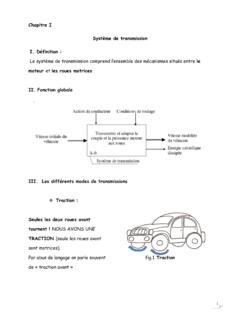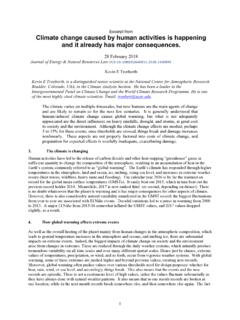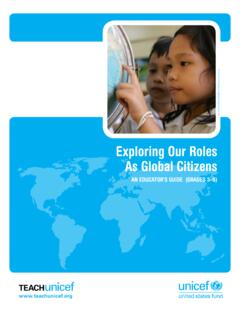Transcription of GLOBAL STUDY ON HOMICIDE - United Nations Office on …
1 GLOBAL STUDY ON HOMICIDEG ender-related killing of women and girls2019 United Nations Office ON DRUGS AND CRIME Vienna GLOBAL STUDY ON HOMICIDE Gender-related killing of women and girls 2019 United Nations , July 2019. All rights reserved worldwide. This publication may be reproduced in whole or in part and in any form for educational or non-profit purposes without special permission from the copyright holder, provided acknowledgement of the source is made. The United Nations Office on Drugs and Crime (UNODC) would appreciate receiving a copy of any publication that uses this publication as a source. Suggested citation: UNODC, GLOBAL STUDY on HOMICIDE 2019 (Vienna, 2019) No use of this publication may be made for resale or any other commercial purpose whatsoever without prior permission in writing from UNODC. Applications for such permission, with a statement of purpose and intent of the reproduction, should be addressed to the Research and Trend Analysis Branch of UNODC.
2 DISCLAIMER The content of this publication does not necessarily reflect the views or policies of UNODC or contributory organizations, nor does it imply any endorsement. Comments on the report are welcome and can be sent to: Division for Policy Analysis and Public Affairs United Nations Office on Drugs and Crime PO Box 500 1400 Vienna Austria Tel: (+43) 1 26060 0 Fax: (+43) 1 26060 5827 Gender related killing of women and girls 1 PREFACE The GLOBAL STUDY on HOMICIDE is a search for solutions. By bringing together the available data, the United Nations Office on Drugs and Crime seeks to shed light on different phenomena, from lethal gang violence and the role of firearms to links with inequalities and gender-related killings, and in this way support targeted action. I hope that the research and analysis contained in the STUDY are used in this spirit not to designate murder capitals but to learn, understand and strengthen prevention.
3 Criminal activity is responsible for many more deaths worldwide than armed conflict and terrorism combined. Unless the international community takes decisive steps, targets under Sustainable Development Goal 16 to significantly reduce all forms of violence and related death rates by 2030 will not be met. The Americas continue to report high HOMICIDE rates. Young men are especially at risk, with a HOMICIDE rate for men aged 18 to 19 estimated at 46 per 100,000 far higher than the risk faced by their peers in other regions. Firearms are also involved far more often in homicides in the Americas than in other parts of the world. By contrast, Europe has seen a decline in the HOMICIDE rate by 63 per cent since 2002 and by 38 per cent since 1990. The rate in Asia has fallen by 36 per cent since 1990. Data collection overall has improved since the previous GLOBAL STUDY on HOMICIDE , but there remain serious gaps in the availability of reliable data for African countries.
4 There are also indications that HOMICIDE is underreported in the official statistics in Pacific countries. This STUDY offers particular insights into the gender-related killing of women and girls. Femicide represents just a small percentage of the overall number of homicides, but our analysis indicates that the drivers of this type of lethal violence require tailored responses. Killings carried out by intimate partners are rarely spontaneous or random, and should be examined as an extreme act on a continuum of gender-related violence that remains underreported and too often ignored. The GLOBAL STUDY on HOMICIDE 2019 also documents successes in preventing and addressing lethal violence. In particular, the STUDY offers examples of effective community-based interventions in settings afflicted by violence, gangs and organized crime. These accounts show that with targeted interventions backed by sustained engagement and trust between communities and law enforcement, bringing down HOMICIDE rates is possible.
5 Yury Fedotov Executive Director, United Nations Office on Drugs and Crime Gender related killing of women and girls 3 ACKNOWLEDGEMENTS The GLOBAL STUDY on HOMICIDE 2019 was prepared by the Research and Trend Analysis Branch, Division for Policy Analysis and Public Affairs, United Nations Office on Drugs and Crime, under the supervision of Jean-Luc Lemahieu, Director of the Division, and Angela Me, Chief of the Research and Trend Analysis Branch. General coordination and content overview Angela Me Andrada-Maria Filip Marieke Liem Analysis and drafting Andrada-Maria Filip Jonathan Gibbons Marieke Liem Kristiina Kangaspunta Editing Luis Sundkvist Data management and estimates production Enrico Bisogno Diana Camerini Sarika Dewan Michael Jandl Alexander Kamprad Mateus Renn Santos Cover design and production Anja Korenblik Suzanne Kunnen Kristina Kuttnig Administrative support Iulia Lazar Review and comments Gender-related killing of women and girls benefited from the expertise of, and invaluable contributions from, UNODC colleagues in all divisions and field offices.
6 Particular thanks are owed to the Justice Section of the Division for Operations and the Gender Team at the Office of the Executive Director. Cover drawing Julija Zaharijevic . The research for this booklet was made possible by the generous contribution of Sweden. Gender related killing of women and girls 5 CONTENTS Preface .. 1 Acknowledgements .. 3 Scope of the booklet .. 7 Introduction to the concept of gender-related killing of women and girls .. 8 Key findings .. 10 Intimate partner/family-related killing of women and girls: scale of the problem .. 13 Scale of the problem in numbers of victims .. 13 Scale of the problem in HOMICIDE rates .. 13 Scale of the problem in shares of all women murdered .. 17 Female burden of intimate partner/family-related HOMICIDE .. 18 Male and female rates of intimate partner/family-related HOMICIDE .. 19 Male and female rates of intimate partner HOMICIDE .
7 21 The context of gender-related killing of women and girls .. 22 Defining and understanding gender-related killing of women and 23 Clustering gender-related killings of women and girls into different forms .. 29 Perpetrators of intimate partner killings of women and girls .. 37 Victim and perpetrator characteristics .. 37 Motives of perpetrators of intimate partner killings of women and girls .. 38 Link between lethal and non-lethal violence against women .. 40 Criminal justice and policy responses to gender-related killing of women and girls .. 46 International responses .. 46 National responses .. 47 Conclusions and policy implications .. 54 Annex .. 57 Gender related killing of women and girls 7 SCOPE OF THE BOOKLET Constituting the fifth part of the GLOBAL STUDY on HOMICIDE 2019, this booklet gives an overview of the scope of gender-related killing of women and girls.
8 It provides in-depth analysis of killings perpetrated within the family sphere and examines forms of gender-related killings perpetrated outside the family sphere, such as the killing of women in conflict and the killing of female sex workers. The booklet explores the scale of intimate partner/family-related killings of women and girls, and describes different forms of gender-related killings of women. It also looks at the characteristics of the perpetrators of intimate partner killings, the link between lethal and non-lethal violence against women, and the criminal justice response. The availability of data on intimate partner/family-related HOMICIDE means that such killings of females are analysed in greater depth than other forms of femicide 1 and that the analysis focuses on how women and girls are affected by certain norms, harmful traditional practices and stereotypical gender roles.
9 Although other forms of gender-related killing of women and girls are described, such as female infanticide and the killing of indigenous or aboriginal women, given severe limitations in terms of data availability, only literature-based evidence is provided. The data presented in this booklet are based on HOMICIDE statistics produced by national statistical systems in which the relationship between the victim and perpetrator and/or the motive are reported. While the disaggregation of HOMICIDE data at the country level has improved over the years, regional and GLOBAL estimates are based on a limited number of countries, with Africa and Asia accounting for most of the gaps.. 1 Throughout this booklet the word femicide is written with quotation marks when it refers to a concept that is not clearly defined and covers acts subject to a certain degree of interpretation.
10 Femicide is written without quotation marks when referring to countries in Latin America that have defined this concept in their national legislation. GLOBAL STUDY on HOMICIDE 2019 8 INTRODUCTION TO THE CONCEPT OF GENDER-RELATED KILLING OF WOMEN AND GIRLS The focus of this booklet is on the killing of women and girls as a result of gender norms. Among the many documents that draw attention to the alarming proportions reached by this phenomenon in all its different manifestations, the 2013 United Nations General Assembly resolution on Taking action against gender-related killing of women and girls is Some national Governments, international organizations, academics and advocates of women s rights use the term femicide to refer to this problem. The notion of gender-related killing, or femicide , requires an understanding of which acts are gender related something that is subject to a certain degree of interpretation.


















